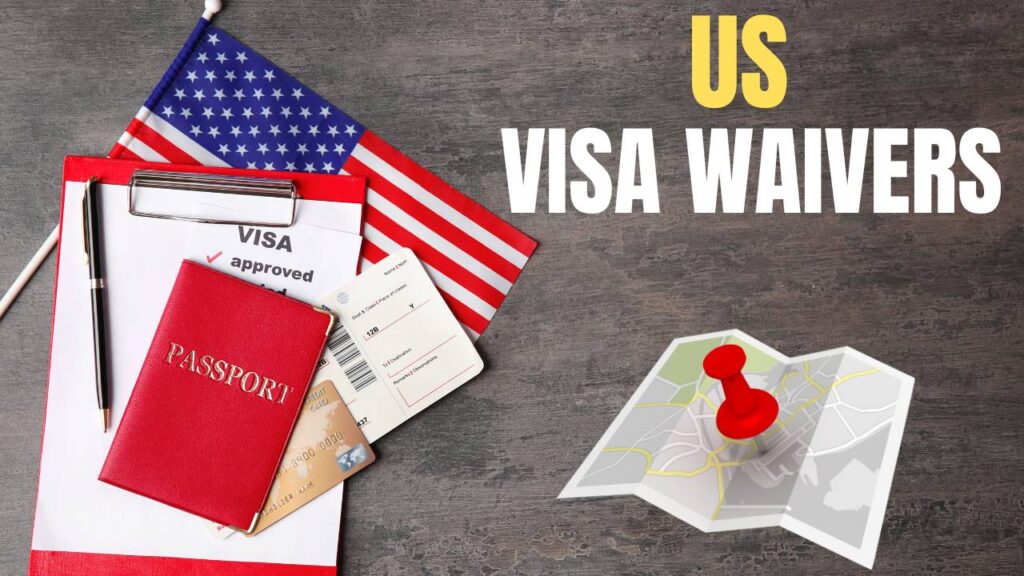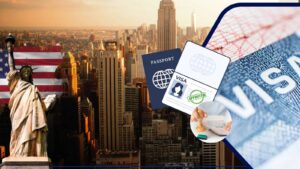As we move into 2025, one of the most highly anticipated updates in global travel is the expansion of the U.S. Visa Waiver Program (VWP). For many travelers worldwide, the U.S. visa waiver presents a significant opportunity to enter the United States without the bureaucratic red tape of applying for a traditional visa. The VWP allows citizens of participating countries to travel to the U.S. for tourism or business purposes for up to 90 days without needing to obtain a visa.
This program has made international travel to the U.S. much easier for millions of citizens from participating countries. With international travel steadily recovering, the U.S. government is considering expanding the Visa Waiver Program to include additional nations.
Here are the details of the U.S. Visa Waivers, which countries are on track to receive the waiver in 2025, and what this means for travelers and the global travel landscape. This expansion could have a major impact on both the global economy and individual travelers’ ease of access to the U.S.
What Is the U.S. Visa Waiver Program (VWP)?
The U.S. Visa Waiver Program (VWP) allows citizens from select countries to travel to the United States for tourism or business purposes without needing to apply for a traditional visa. To qualify for the program, travelers must meet specific criteria, including possessing an electronic passport and obtaining an authorization through the Electronic System for Travel Authorization (ESTA).
The U.S. Visa Waivers have long been an essential part of facilitating smooth and efficient international travel, particularly for business professionals, tourists, and diplomats. The VWP eliminates the long and often costly visa application process, allowing travelers to focus on their visit instead of paperwork.
The program, still requires travelers to comply with U.S. immigration regulations and follow all rules to ensure a safe and secure visit. The U.S. has long been committed to maintaining a balance between facilitating international travel and ensuring national security, which has shaped the parameters of the Visa Waiver Program.
The U.S. Visa Waiver Program is also a strategic tool for promoting tourism and business exchanges while ensuring national security. Participating countries must meet certain security and immigration standards to be included in the program, which involves information sharing and cooperation on border security issues.
By streamlining travel and improving bilateral relations, the program strengthens ties between the U.S. and participating countries. In addition, the VWP enhances security cooperation, enabling the U.S. to track travelers who enter the country under the program, thus reducing the risk of illegal immigration or criminal activity. This dual focus on convenience and safety has contributed to the program’s success over the years.
Countries Currently in the U.S. Visa Waiver Program (as of 2025)
As of 2025, there are 40 countries in the U.S. Visa Waiver Program. Some of the most notable ones include European Union member states like Germany, France, Italy, and Spain, along with developed nations such as Japan, South Korea, and Australia. These countries have long-established travel relations with the U.S., making them key contributors to global tourism and commerce.
In addition to these well-known countries, other nations such as New Zealand, Singapore, and Taiwan have also benefitted from the program, making travel more accessible to their citizens. These countries’ participation in the VWP has fostered closer economic, cultural, and diplomatic relationships with the U.S., creating a mutually beneficial environment for both sides.
These nations have established a history of compliance with U.S. security and immigration standards, which has made them eligible for the program. Each of these countries has worked diligently to meet the U.S. government’s requirements regarding border security, data sharing, and immigration control.
These countries maintain a low visa refusal rate, which is a key factor in determining eligibility for the Visa Waiver Program. As we look toward 2025, there is increasing speculation about which new countries will be added to the list, as travel patterns shift and global political dynamics evolve.
Which Countries Are Getting U.S. Visa Waivers in 2025?
The U.S. government has been in discussions about expanding the Visa Waiver Program to include several countries that have shown growth in travel relations and strong security partnerships with the United States. While no official list has been finalized as of mid-2025, several countries are widely expected to receive U.S. visa waivers in 2025. The expansion of the VWP is seen as a strategic move to strengthen diplomatic, economic, and security ties with key global players.
As international travel recovers and global commerce flourishes, more nations will likely meet the criteria for inclusion in the program. Below are some of the countries that are considered strong candidates for the U.S. Visa Waiver Program in 2025.
1. Chile
Chile has been one of the top candidates for inclusion in the U.S. Visa Waiver Program for several years. Over the years, the country has demonstrated a robust economy, political stability, and strong diplomatic ties with the U.S. Chilean travelers have been seeking greater ease of access to the United States, particularly in the fields of business and tourism. With Chile’s growing role in global trade and economics, it is anticipated that the country will soon be granted a visa waiver. This will help Chile’s business and tourism sectors thrive and allow its citizens to engage more freely with U.S. markets.
Chile’s inclusion in the U.S. Visa Waiver Program is expected to stimulate greater collaboration between the two nations, particularly in the areas of technology, trade, and scientific research. In addition, it will likely bolster the already robust diplomatic and cultural relations, benefiting both Chile and the U.S. economically.
2. Argentina
Argentina has expressed interest in being included in the U.S. Visa Waiver Program for several years. Despite facing economic challenges in recent years, Argentina has maintained positive relations with the U.S. Argentina is a growing hub for business, tourism, and technology in South America, and many believe that being part of the VWP will unlock further opportunities for growth. In 2025, there is a growing expectation that Argentina’s inclusion in the program could help boost trade, tourism, and cultural exchanges between the two nations. Argentine travelers will have more access to the U.S. for tourism and business purposes, which will strengthen bilateral relations.
The U.S. government recognizes the importance of Argentina as a regional leader and a key player in Latin America. By adding Argentina to the Visa Waiver Program, the U.S. could foster more dynamic economic and political relationships in the region, with enhanced cooperation on security, counterterrorism, and economic matters.
3. Brazil
As the largest country in South America and an emerging economic power, Brazil has been on the radar for inclusion in the U.S. Visa Waiver Program for some time. Brazilian travelers make up a large portion of international visitors to the U.S., particularly to major cities like Miami and New York. The U.S. has also been keen to strengthen ties with Brazil, particularly given its significant role in the region. If Brazil is granted a visa waiver, it will be a major milestone for the region, as it will facilitate easier business and tourism exchanges between the two countries.
With Brazil’s increasing economic influence in global markets, the inclusion of its citizens in the U.S. Visa Waiver Program will enhance trade and investment flows. This would also benefit U.S. businesses seeking opportunities in Brazil, particularly in technology, energy, and agriculture.
4. United Arab Emirates (UAE)
The UAE, with its high level of business activity, strong diplomatic relationships with the U.S., and significant expatriate population, is also a likely candidate for the Visa Waiver Program. Dubai is a major hub for international travelers, and granting the UAE a visa waiver would facilitate easier business and tourism connections between the two countries. The UAE has long been an important partner for the U.S. in the Middle East, and its inclusion in the VWP would strengthen those ties further.
The economic and cultural connections between the U.S. and the UAE are robust, with many American companies operating in the region. By allowing UAE citizens easier access to the U.S., both countries stand to benefit from increased trade, investments, and cultural exchanges.
5. Israel
Although Israel has long been a close ally of the United States, it has yet to be included in the Visa Waiver Program. With growing security cooperation, intelligence sharing, and strong bilateral ties, Israel is a prime candidate for inclusion. As of 2025, there is growing optimism that the U.S. will extend the visa waiver to Israeli citizens, particularly given the significant number of travelers and business leaders from Israel visiting the U.S. Many see this as a natural next step in enhancing U.S.-Israel relations, especially considering the strong cultural, economic, and security bonds between the two nations.
Israel’s addition to the U.S. Visa Waiver Program would significantly streamline travel for Israeli citizens and strengthen the already strong ties between the two countries. The waiver would particularly benefit Israel’s thriving technology sector, as many Israeli entrepreneurs and tech professionals travel to the U.S. for business opportunities.
Process of Gaining U.S. Visa Waivers
For a country to be granted a U.S. Visa Waiver, the U.S. Department of Homeland Security (DHS) and the State Department evaluate the country’s visa refusal rate, the security of its passport issuance, and its ability to cooperate in counterterrorism efforts.
The process involves thorough negotiations, with countries working closely with the U.S. government to ensure that both sides meet agreed-upon standards.
- Negotiations and Bilateral Agreements: Countries must enter into a series of negotiations and agreements with the U.S. government, outlining mutual responsibilities related to immigration control, security, and information sharing. This process can take several years, as both sides must ensure the implementation of proper safeguards.
- Security Compliance: Countries must meet stringent U.S. security standards, including the use of biometric passports and systems for tracking immigration. The U.S. will not grant a visa waiver unless the country demonstrates its ability to share data and ensure the security of its own borders.
- Approval Process: Once all criteria are met, a country is formally invited to join the program. The U.S. government also conducts periodic reviews to ensure that participating countries continue to meet security and compliance requirements.
The U.S. government also monitors countries on the program, and those who do not maintain adequate security measures or have a high visa refusal rate may be removed from the list.
Benefits of U.S. Visa Waivers for Travelers and the U.S.
Expansion of the U.S. Visa Waiver Program to more countries in 2025 is beneficial for both travelers and the United States:
1. Easier Access for Travelers
For citizens of countries included in the VWP, the process of traveling to the U.S. becomes much simpler. Instead of applying for a visa, travelers can quickly receive approval through the Electronic System for Travel Authorization (ESTA). This ease of travel encourages more tourists, businesspeople, and cultural exchange, boosting international relations.
Travelers benefit from reduced processing time and fewer barriers to visiting the U.S. This will likely result in increased numbers of visitors from VWP countries, which will further solidify the U.S.’s position as a leading global destination for tourism, business, and study.
2. Increased Trade and Business Opportunities
Countries with U.S. visa waivers experience higher levels of trade and business investments. For U.S. companies, easier access to foreign markets means increased business opportunities, partnerships, and revenue. This can also help promote tourism and investments, benefiting the U.S. economy. By streamlining the process for international visitors, the U.S. opens the door to more business deals, foreign investments, and economic growth.
3. Strengthened Diplomatic Relations
Expanding the VWP helps solidify diplomatic ties between the United States and other nations. Countries that receive visa waivers tend to have stronger partnerships with the U.S., especially in areas like security, technology, and international cooperation. The waiver represents a symbolic gesture of trust and mutual respect between the U.S. and the participating country, which benefits both sides politically and economically.
Future of the U.S. Visa Waiver Program
As more countries join the U.S. Visa Waiver Program in 2025, the program will continue to evolve. The U.S. government actively streamlines immigration processes while ensuring national security. The development of new technologies, such as biometric screening and advanced data sharing, will simplify the process for both travelers and immigration authorities.
FAQs
1. What are U.S. Visa Waivers?
U.S. Visa Waivers allow citizens of certain countries to travel to the U.S. for tourism or business without needing a visa.
2. Which countries are eligible for U.S. Visa Waivers?
Citizens from 40+ countries, including most EU nations, Japan, and Australia, can participate in the U.S. Visa Waiver Program.
3. How long can I stay in the U.S. with a Visa Waiver?
You can stay in the U.S. for up to 90 days without a visa under the Visa Waiver Program.
4. Do I need to apply for ESTA before traveling to the U.S.?
Yes, travelers must apply for an Electronic System for Travel Authorization (ESTA) before flying to the U.S.
5. Can I work in the U.S. under the Visa Waiver Program?
No, the U.S. Visa Waiver Program only permits travel for tourism or business. You cannot work or study under this program.
6. Can I extend my stay if I enter the U.S. on a Visa Waiver?
No, the U.S. does not allow extensions of stay under the Visa Waiver Program. You must leave within 90 days.
7. What happens if I overstay my Visa Waiver?
Overstaying can lead to penalties, including being barred from re-entering the U.S. for several years.
8. Are there any new countries joining the Visa Waiver Program in 2025?
Yes, more countries are expected to join the U.S. Visa Waiver Program in 2025, making travel easier for citizens of those nations.
9. What documents do I need for the Visa Waiver Program?
You need a valid passport from an eligible country and an approved ESTA to travel to the U.S.
10. Can I use the Visa Waiver Program for long-term stays?
No, the Visa Waiver Program is designed for short stays up to 90 days. For longer stays, you need a visa.






